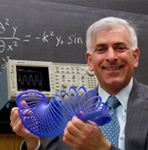- Home
- About » »
- 2014 Festival » »
- Volunteer » »
- School Programs » »
- Affiliate Events » »
- Newsroom » »
Years Participated: 2010 2012 2014


Astrophysicist Matthew Bobrowsky and his research team made
international news last year when they revealed that some stars in our
galaxy have both excess carbon and oxygen in the dust that surrounds
them — a rare combination that they say could shed new light on the
origin of the chemical elements in life on Earth. This discovery is an
example of the scientific achievements that Matthew has played a role in
during his astronomical career.
Currently on staff in the
Department of Physics at the University of Maryland, he is now also
using his expertise to further pursue another burning passion of his:
enhancing science education at all levels, both in schools and in the
wider community as well. “In addition to research, I absolutely love
bringing the excitement of science to students, teachers, and the
public,” says Matthew. “I previously worked in the Office of Public
Outreach at the (Hubble) Space Telescope Science Institute, and prior to
that, at the Challenger Center for Space Science Education — places
where I developed science curriculum materials and presented countless
workshops to teachers.”
As a scientist, Matthew specializes in
the study of planetary nebulae — clouds of gas expanding outward from
aging stars — using various high-tech telescopes, including the Hubble
Space Telescope. He used the Hubble to discover the Stingray Nebula, the
youngest known planetary nebula. This nebula, characterized by its
graceful, gentle curves and symmetry, can be viewed at http://apod.nasa.gov/apod/ap011006.html
“Students
learn best through an inquiring approach, involving experimentation,
creativity, and investigation — similar to a way a scientist would
ponder a question during research,” says Matthew. His determination to
illustrate just how science works compelled him to author The Process of
Science...and its Interaction with Non-Scientific Ideas: A Guide for
Teachers, Students, and the Public. This publication can be viewed at http://aas.org/education/The_Process_of_Science
Matthew
has received multiple awards for teaching excellence, and is frequently
asked to be the guest speaker at special events — especially
non-scientific events, as he specializes in conveying the excitement of
science to non-scientists.
Matthew received his Ph.D. and M.S.
degrees in Physics and Astronomy from the University of Maryland, and
his B.A. degree in Physics and Astronomy from Northwestern University.
When
not conducting outreach and exploring the mysteries of the universe,
Matthew enjoys travel, music, art, theatre, and exploring the natural
beauty found in so many places.
He never grows tired of
marveling at nature and sharing those marvels with others, as ideas keep
popping into his head about ways to excite kids about science. “Last
year, for the International Year of Astronomy celebration,” he says, “I
created a special presentation commemorating the 400th anniversary of
Galileo’s first use of the telescope: ‘Telescopes: Giant Eyes on Earth
and in Space’.”
Click here for more information.